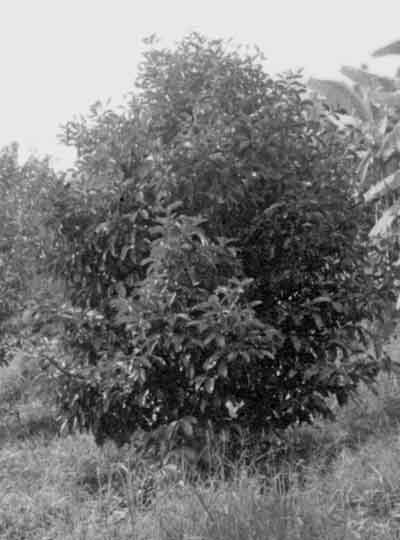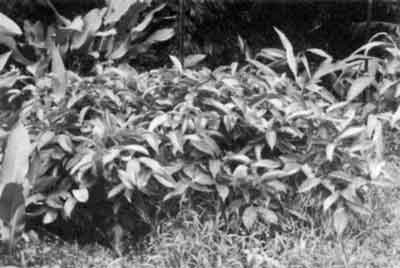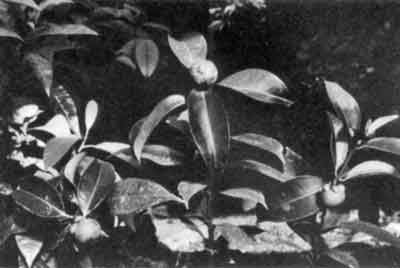
MANGOSTEEN SECRETS DIVULGED
SCIENTIFIC NAME: Garcinia mangostana
FAMILY: Guttiferae
In reply to a letter to the Editor in the May Newsletter from Bill Whitman of Florida, whom I met in Hawaii in 1986: I have great respect for his knowledge of exotic fruit and I would like to give a few more hints just to tease Bill's curiosity.
Bill asks what will induce me to divulge my secrets on fruiting grafted purple mangosteens. The theory is easy - the practical, a little more difficult.
 | The theory is that these trees need to be: (1) Nutritionally healthy. (2) Stressed through winter and early spring. (3) Well-watered from mid-spring until a floral flush emerges. After that, normal crop care is required. In practice, it is difficult to apply the perfect balance of nutrition and it is difficult to stress a tree through a wet winter. Sunlight is an important factor. The more sun exposure, the more carbohydrate build up in leaves and branch tips and therefore the more chance of floral differentiation. However, I have seen examples of grafted mangosteens fruiting in partial shade, but they tend to fruit biennially and with smaller crops. Stressing should be done under strict guide lines, mainly because plants can be set back if stressed too severely. Stressing consists of two separate functions:
(1) Withholding all fertilizer from the beginning of winter. Organic fertilizers which are slow to break down should be withheld earlier, from about mid-autumn.
(2) Water stressing simply allows the soil to dry out sufficiently to restrict nutrient uptake. This allows the carbohydrate levels to increase sufficiently to create conditions that favour flowering. Mangosteen branch tips and stems show a marked shrivelling effect when moisture levels fall too low. They quickly recover when water is applied. Use this characteristic as a guide for minimum water requirements. | |
| 10-Year-Old Mangosteen seedling. First crop approximately 400 fruit. |
Fruiting mangosteens need a dormancy period from late autumn to mid-spring. They normally flower from mid to late spring, but need a considerable amount of water to trigger the floral flush. A week of good rain in late spring gives best results, probably because of the nitrogen content. One can order rain but it is not always delivered when you need it!
Well, Bill, that's most of my secrets divulged. Of course I've kept back a few little points for my consultancy work in the fields of mangosteens, rambutans and durians. However I'll throw in a couple of other points for you to ponder.
The first photo is of a 10-year-old seedling purple mangosteen which produced approximately 400 fruit in 1990 - its first year of fruiting. It is fertilized, stressed and watered under the same program as the grafted trees. It is growing in a sub-tropical climate where winter temperatures fall to as low as 3°C (37°F). I think it must be close to a record for first year production.
One is a photo of a marcotted purple mangosteen which I planted 5 years ago (it's the only one I've ever heard of). Although it came off a mature tree it has not yet fruited. It is growing vigorously but asymmetrically. It is about one metre high and about 2 metres wide. It was a lateral branch when marcotted and now obviously lacks a leader shoot. Its shy bearing habit is probably due to the very wet area in which it is growing. Its lack of overall height would also be a factor.
The third photo shows three grafted mangosteens, still in their pots, each bearing one fruit. They were grafted approximately 9 months earlier.
 |  | |
| Marcotted mangosteen - wider than it is high | 3 purple mangosteens in their pots with one fruit each |
DATE: July 1990
* * * * * * * * * * * * *
